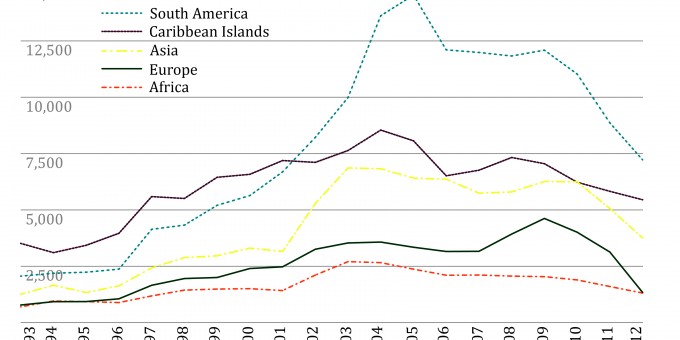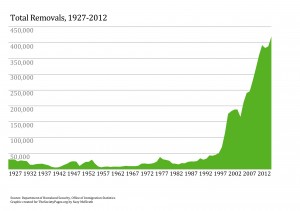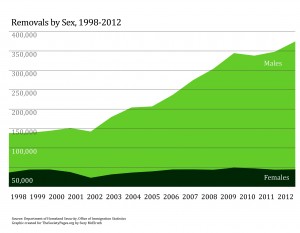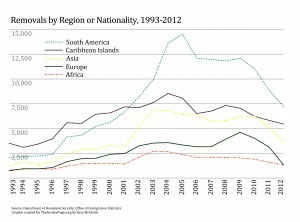
This past Spring, activists organized marches around the country, protesting President Obama’s record-breaking two million removals (the official term for deportations accompanied by an order of removal).
The two-million milestone is significant because it is more than the sum total of all removals prior to 1997. It is more than were removed during President George W. Bush’s eight-year term.
Indeed, a recent New York Times article renders it evident that removals are at historic highs, that most deportees are not serious criminals, and that many deportees have strong ties to the United States.
Still, most public debate has been over whether President Obama’s deportation record is truly record-breaking and whether deportations have targeted criminals.

As Adam Goodman notes, there have been fewer returns during the Obama administration than during previous administrations, but Obama’s deportation policy is harsher because removals carry lasting consequences: Removal orders are accompanied by bans on reentry to the United States whereas returns allow for a later reentry to the U.S. (Both returns and removals can be colloquially referred to as deportations, leading to some confusion over the numbers.)
One of the critiques detractors level against immigrant rights activists’ anger over the removal numbers is that not all of those two million removals involved people living in the United States. This is true, just as it was during the previous administration.
Moreover, even if only one quarter of those removed each year are people living the United States, this is still a lot of removals. It is more than the total of all people removed in any year prior to 1997. That year marks a turning point because the laws governing deportation changed, but have hardly budged since. This means that the number of removals is closely linked to immigration law enforcement decisions—the laws have not changed, but enforcement practices have.
Whereas Congress makes the laws governing immigration and deportation, it is up to the Executive Branch to prosecute and deport immigrants. The 1996 acts channeled unprecedented levels of funding to immigration law enforcement. This funding was enhanced even more with the transfer of immigration law enforcement from the Immigration and Naturalization Service to the Department of Homeland Security (DHS).The build-up of DHS since 2003 has translated into even higher numbers of deportations. These target specific populations.
Immigration researchers including Doris Meissner, Donald Kerwin, Joanna Dreby, and Daniel Kanstroom have made a convincing case that 1) removal rates are higher than they ever have been; 2) the federal government spends more money on immigration law enforcement than all other federal law enforcement agencies combined; and 3) deportation laws are unusually draconian in their consequences for individuals and families. Thus, it is worthwhile to consider who this enforcement targets.

The primary targets of immigration law enforcement are men. Women make up half of undocumented immigrants, but men account for 90% of all deportees. The increase in deportations since 1996 has primarily targeted men.
The tremendous rise in deportations has also disproportionately affected some national origin groups. Nearly all of the increase in removals since 1998 is due to an increase in the number of Mexicans and Central Americans removed.
The total increase in removals from 1998 to 2011 was 227% (from 173,146 to 391,953). Mexicans experienced the largest increase in absolute numbers. Central Americans experienced the largest proportional increase: 4.34 times as many Central Americans were deported in 2011 as in 1998. Notably, the number of European, Asian, Caribbean, and African deportations remained flat.
Overall, deportees disproportionately go to the Western Hemisphere. In 2011, 97.5% of all deportees were sent to the Americas, with only 2.5% going to Europe, Asia, and Africa. Deportation rates are not reflective of the countries of origin of non-citizens in the U.S., as nearly all deportees are Latin American even though a quarter of undocumented immigrants are from other regions of the world.

The primary targets of mass deportation are Mexican and Central American men. In this sense, mass deportation is a civil rights issue as much as an immigrant rights issue.
Recommended Reading:
Applied Research Center. 2011. “Shattered Families: The Perilous Intersection of Immigration Enforcement and the Child Welfare System.” November. This human rights report explains how the children of deportees and detainees end up in foster care.
Joanna Dreby. 2012. “The Burden of Deportation on Children in Mexican Immigrant Families,” Journal of Marriage and Family 74(4):829-845. Provides a framework for understanding the repercussive effects of deportation in Mexican families and communities.
Tanya Golash-Boza and Pierrette Hondagneu-Sotel. 2013. “Latino Immigrant Men and the Deportation Crisis: A Gendered Racial Removal Program,” Latino Studies 11(3): 271-292. Explains how deportation policies expanded in the post-9/11 era and how these policies target black and Latino male immigrants.
Daniel Kanstroom. 2012. Aftermath: Deportation Law and the New American Diaspora. New York: Oxford University Press. A legal explanation of how people are deported and what happens afterward.
Ryan D. King, Michael Massoglia, and Christopher Uggen. 2012. “Employment and Exile: U.S. Criminal Deportations, 1908–2005,” American Journal of Sociology 117(6):1786-1825. This article explores the links between U.S. unemployment and criminal deportations over nearly a century.

Comments 1
Penny Scott — August 13, 2014
I still can't make any sense out of the numbers. I'd like to know what the total number of illegal immigrants living in the US is by year, over the last ten years. Does anyone have these numbers? Is the total going up or going down?
Since the vast majority of illegal immigrants are poor and unskilled, do they not add to the much discussed problem of inequality? The US has fifty million people on Medicaid and on food stamps. Does it make any sense to import more poor people?